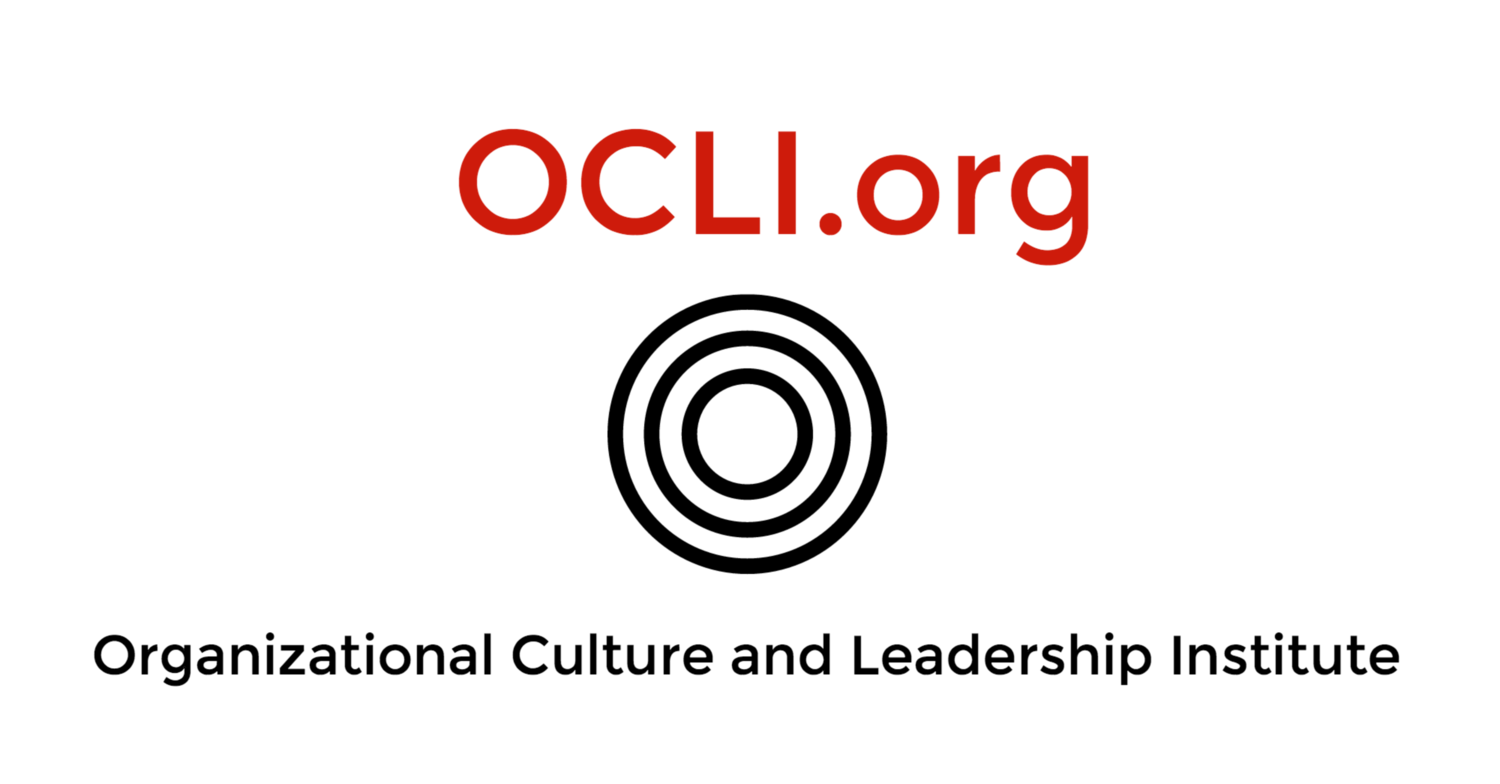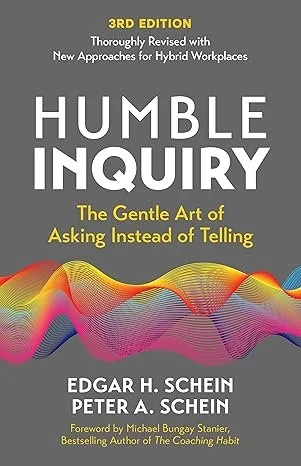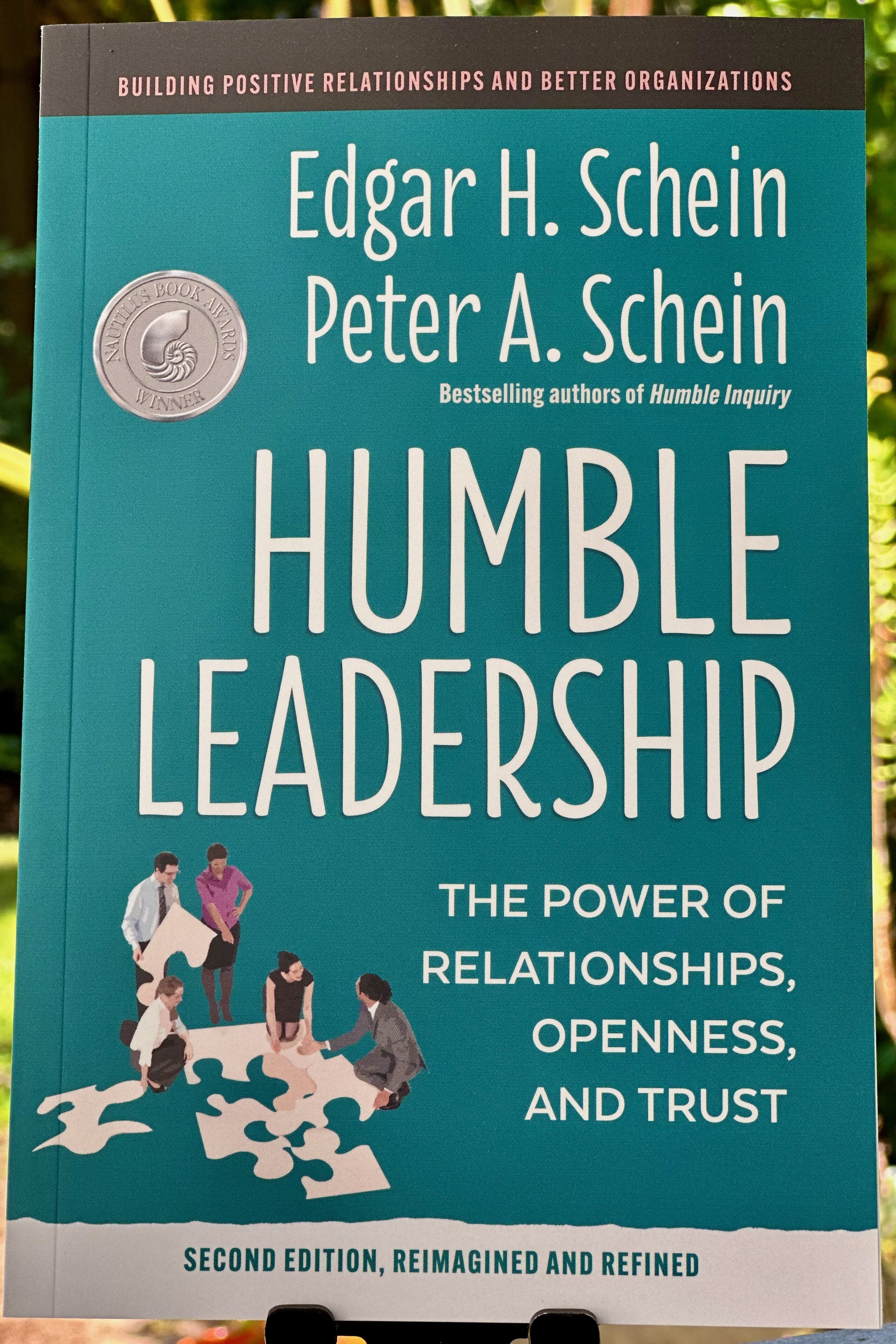I am very pleased to feature the 3rd Edition of our book about asking instead of telling. I wrote this edition solo after my Dad passed away in early 2023. I made a number of changes and additions, but it remains our work, our passion. I did my best to balance theory with practical examples and exercises in a complete and compact book. Hope you enjoy it!
Humble Leadership 2nd Edition
Proud to announce the release of Humble Leadership Second Edition!
This work brings together decades of scholarship and hands-on experience with organizational culture, group dynamics and leadership development. This is Ed's and my last effort as co-authors. We were both very happy with how it all came together last winter, only a few weeks before Ed passed away in late January. We took some creative license to add some very important stuff to what we had presented in the first edition, including a little more on culture and groups. And we did all we could to keep it simple and to the point! A couple Ed sayings might peak your interest: 1) "Leadership is a group sport" - If you believe your success as a leader is a reflection of the kinds of relationships you nurture, in 360 degrees, we think you will find the frameworks and stories in this book helpful and encouraging. 2) "The only thing of real importance that leaders do is to create and manage culture". Sure, easier said than done. Hopefully this book will give you some ways to be specific in thinking about the culture you create, when and how it needs to change. ~ Peter Schein
Edgar H. Schein A Great Life!
March 5, 1928 - January 26, 2023
Ed Schein passed away peacefully at home in Palo Alto, California on January 26th. He and his son Peter had just finished a productive afternoon of work with organization development colleagues. He passed without illness or suffering, as he had always hoped he would. He was 94.
Edgar Henry Schein was born in Zurich Switzerland in 1928 to Marcel Schein and Hilde Schonbeck, both physicists. His childhood was spent in Prague, Odessa and Zurich before coming to America at age ten where his father became a professor in the University of Chicago Department of Physics. Ed cherished his childhood in Hyde Park with his friends playing sports, cards and chess. His undergraduate education began at University of Chicago, where he earned a BPhil, followed by a BA and an MA in social psychology at Stanford University. He went on to get his PhD in social psychology from the Harvard University School of Social Relations. He also joined the U.S. Army as a Captain charged with research on Chinese handling of POWs following the Korean War resulting in his first book, Coercive Persuasion (1961). His time with subjects at Walter Reed Army Medical Center also coincidentally brought him to Mary Lodmell, the love of his life, mother of his children and life partner until her passing in 2008.
Ed spent forty years as a professor at Massachusetts Institute of Technology’s Sloan School of Management. He held the titles Society of Sloan Fellows Professor of Management Emeritus and Professor Emeritus of Work and Organization Studies. In 2011, he moved to Palo Alto, California, where he lived independently at “The Vi,” characteristically getting involved in on-site committees and offering his wisdom about organizations and relationships for the improvement of all residents’ lives.
Ed always considered family his greatest legacy, followed closely by the numerous books and papers he authored as well as his consulting for individuals and organizations around the globe. Recognized as one of the founders of the field of organizational psychology, his most notable early contributions were in the fields of organizational development and culture, process consultation, and career development. His 1965 book Organizational Psychology came out in 3rd edition (1980) followed by his Organizational Culture and Leadership which had 5 editions between 1985 and 2017, Helping (2013), Humble Inquiry (2014) which won the business book of the year award from the Department of Leadership of the University of San Diego, Humble Consulting (2016). Many of his recent books emerged from his rich collaboration with his son Peter through their joint project Organizational Culture and Leadership Institute (OCLI.org). These include Humble Leadership (2018) which received a silver medal in the Nautilus Book Awards, the Corporate Culture Survival Guide, 3rd Edition (2019), and Humble Inquiry (2nd Ed. 2021). His two case study monographs were DEC is Dead; Long Live DEC, (2003) as well as a cultural analysis of Singapore's economic miracle (Strategic Pragmatism, 1996). Career Anchors Reimagined with John Van Maanen and Peter Schein (2023) and Humble Leadership with Peter Schein (2nd Ed. 2023) are soon to be published posthumously.
Among his awards, Ed received the 2009 Distinguished Scholar-Practitioner Award of the Academy of Management, the 2012 Lifetime Achievement Award from the International Leadership Association, the 2015 Lifetime Achievement Award in Organization Development from the International OD Network. He holds an Honorary Doctorate from the IEDC Bled School of Management in Slovenia.
Ed was an avid tennis player, nature-lover, opera enthusiast and landscape sketcher. In the 1960s his family summered lakeside in Bryant Pond, Maine while leading early groups at the National Training Labs (NTL). Later, he gathered his family in Truro, MA for over twenty summers and taught at the Cape Cod Institute. Ever engaged, he devoted much of his time to advocacy around global warming in recent years, eventually co-organizing a collection of invited essays, Social Scientists Confronting Global Crises (Jean Bartunek, ed. 2022).
Ed is survived by his daughters Louisa Schein (Ernie Renda), Liz Krengel (Wally), and his son /business partner Peter Schein (Jamie). Ed was also blessed with seven grandchildren - Alex, Peter and Oliver Krengel; Sophia and Ernesto Renda; and Annie and Stephanie Schein - as well as three great grandsons Logan, Caius and William Edgar.
Ed treasured and encouraged cultivating uniquely personal relationships within both work and family circles, including with his seven grandchildren as they became adults. We will dearly miss his warm and curious inquiry, his penchant for learning, and his spirit for helping.
In lieu of flowers, donations may be made to Massachusetts Audubon Society where Ed served on the board (https://www.massaudubon.org/), Cambridge Neighbors, an organization Ed helped to found (https://cambridgeneighbors.org/), Environmental Defense Fund (https://www.edf.org/), or other environmental organizations.
Ed's family will hold a private memorial this spring after he is interred at Mt. Auburn Cemetery in Cambridge, MA.
From Last Year: A Discussion of Humble Inquiry
Humility is easier said than done. We think leaders are “supposed” to give orders and advice. It turns out that TELLING people what to do instead of ASKING their perspective can suck the motivation and passion right out of our teams. You don’t want people checking out, getting defensive, or feeling targeted. You do want colleagues feeling safe and empowered to share what they know so that collectively your teams can make better decisions.
Nevertheless, our status-seeking, individualistic, competitive world still pushes us in the compete and control direction. Virtues like humility, curiosity, even vulnerability, are often undervalued because they don’t fit into that “control” posture. Yet when we develop humble inquiry skills, everything we’re doing together as a team starts getting more effective and hopefully easier.
The New Edition
It all starts, again, with a story Ed has told many times.
And yet this edition makes a newer and more urgent case for Humble Inquiry, the gentle art of asking instead of telling.
We see humble inquiry as critical for two vital human pursuits — Building open and trusting “level 2” relationships and getting to the truth of what is really going on (content and context). We have made a lot of changes to Ed’s best-selling appeal to leave behind the “culture of tell”, and evolve toward a more open and attentive form of relating, managing and leading. Here are some excerpts:
From the Preface:
“We hope in this second edition to address the inevitability that as the world becomes more interlinked and multicultural, most of the time we do not know what is really going on or why this is happening now. We hope that the deeper and broader approach to Humble Inquiry presented here will help you to see around and through the brazen telling provided by others, and to deepen the skills to learn what really matters in the shared context of many conversations in many relationships that are woven into your social fabric, at work and at home.”
From Chapter 8:
“Humble Inquiry presumes continuous assessment of the situation, so asking oneself what else is happening may be an essential pre-condition for effective inquiry. We do not want to fall into the trap of not reflecting and then plowing in with a sequence of telling or leading questions that betray a lack of situational awareness. The tough boss who has always relied on telling may find, upon reflection, that he or she has the capacity and even the desire to try a different approach, such as going to a direct report and asking kindly, “What’s on your mind today? Tell me about it . . .” Rather than adding something more to do that day, such inquiry might actually take some pressure off the workday at hand.”
From the final section “Twelve Mini Case Studies…”:
“Humble Inquiry is an attitude that can and should show up in different kinds of situations. The most important aspect of the attitude is what we are calling situational awareness, assessing in every conversation what your purpose is and how it aligns to the situation at hand. You may just be exploring, having fun, or trying to convince someone of something; you may be trying to build a relationship or decipher what may really be going on if the situation is ambiguous or full of conflict. Everything you do next will be an intervention, even if you just stay in a silent observer mode, and will convey some aspect of your purpose to the other person in the conversation. It will help to learn to become mindful of the different consequences of what you say.
For each of the twelve situations that we describe below, ask yourself what you would say and make a note of it in the space provided. After you are done, read the several possible responses and how each relates to the concept of Humble Inquiry. You can then compare what you think you might have said to the various alternatives.
This is not a test and you don’t get a score. This is an opportunity to observe yourself in action and become more mindful of how you operate…
…6. Your fellow team members are becoming noticeably less engaged in weekly staff meetings, and you are not sure why. As a team member you are worried about this. You are at a meeting where the boss is not present.
What do you say or do?”
Our second edition of Humble Inquiry is for sale now from Amazon and other book retailers. As always, please feel free to let us know what you think!
Humble Leadership Honored as Nautilus 2018 Silver Award Recipient
Humble Leadership, 2018
Ed and Peter are happy to announce that the 2018 release Humble Leadership has been selected as a Silver Medalist by the Nautilus Book Awards in the category of Business and Leadership.
Read moreIs Humble Leadership New and Different?
There is much discussion these days about “servant leadership” and “transformational leadership”. These are important concepts that will continue to be debated and refined as we all seek ways to re-humanize organizations. That said, humble leadership is something different, not mutually exclusive, but categorically different, in the following ways:
Read moreInterview on Humble Leadership in Forbes Magazine online →
Berrett-Koehler's Maren Fox connects "Women in Leadership" to Humble Leadership →
For all of the progress women in leadership are making in the workplace, there are still stark reminders of the challenges that face them. For example, a 2018 report by Grant Thornton showed that 75 percent of responding businesses have at least one woman in senior management—an impressive increase from 66 percent the year before. However, the proportion of women in senior management roles actually dropped, from 25 to 24 percent.
There is much work left to do. Women in leadership—as well as women striving to advance into leadership—might well encounter the glass ceiling, so women must continue do everything they can to break it. First priority: finding your leadership voice.
Having a leadership voice is more than speaking up when the situation presents itself. It’s also about how you communicate with coworkers, peers, superiors, and subordinates alike—it’s about building influence and personal brand. Here is a closer look at the importance of finding your leadership voice:
Who Do You Serve?
In their book, Humble Leadership: The Power of Relationships, Openness, and Trust, Edgar and Peter A. Schein advance the idea of “personization”—building relationships with the whole person who you are communicating with and not just his or her workplace role. “Personizing has nothing to do with being nice, giving employees good jobs and working conditions, generous benefits, or flexible working hours,” they write. “It has everything to do with building relationships that get the job done and that avoid the indifference, manipulation, or, worse, lying and concealing that so often arise in work relationships.”
Read on … https://ideas.bkconnection.com/women-in-leadership-finding-your-leadership-voice
Ed Schein and Tim Kuppler Discuss Culture
New Ideas in Organizational Culture and Leadership
by Edgar Schein and Tim Kuppler (Interviewer)
Originally posted on Saturday, January 7, 2017
Edgar Schein and the subject of organizational culture are forever linked due to his pioneering efforts in the field. His hallmark book, Organizational Culture and Leadership, has been a resource for more than 30 years. Ed shared insights from an upcoming fifth edition (now released) of this important book during an interview at the Human Synergistics Ultimate Culture Conference, October 2016.
The original motivation for the book
Ed explained his original motivation came from things he encountered in his consulting. He shared an important example as he contrasted his initial work with Digital Equipment Corporation (DEC) and Ciba-Geigy. DEC didn’t want him telling them how to be better at something; they wanted process help. Ciba-Geigy was “the opposite”— they wanted expert advice. He wondered what was going on in these organizations.
The concept of Culture DNA
“Gradually over the years, as I got more and more of this experience, I realized that there are what you might call DNA factors in the cultural genome.” Ed, who has consistently warned against oversimplifying the topic of culture, said he is more interested in the DNA of the culture. “What are the things that, when we try to change cultures, turn out to be huge barriers?” Ed explained, “We say, for example, we want a team-based organization. If you suggest in a US company that maybe, in that case, you ought to change the reward system to be team based…and make groups accountable, you get kind of a frozen look from your client. What’s behind that resistance? What’s behind it is that at that point, we’re not dealing with an organizational culture at all. We’re dealing with the DNA of the US culture, and the DNA of the managerial culture, which is heavily individual-accountability based.”
You cannot change culture in the middle. ~ Edgar Schein
The importance of macro cultures
“I began to realize toward the end of the fourth edition that we’ve got to become more international and really look at the DNA that’s embedded in the country value systems and country assumptions about how things should be. One of the major differences in this next edition is a great deal more emphasis on how organizations are nested in larger cultural units. A US organization is based in the US, and that may even vary in different parts of the US. A German organization is based in Germany, and what’s the role of these national cultures?” Ed continued, “As culture changers, which is what most of us here are probably supposed to be with great difficulty, we have to learn how to deal with these national DNA factors in the very work that we do.”
Change is all about relationships
“You can’t produce changes if you don’t have a relationship with your client. Lo and behold, you discover that every society discriminates around different kinds of relationships. At one level, we have a transactional relationship: professional distance, role-related, and bureaucratic,” says Ed. “In those same societies—and think in the US, for example—we know the difference between a role-related, distant, bureaucratic relationship and a personal relationship.”
Ed believes you need to decide if “you are going to treat the other individual as a total human being or just as a representative of a role.” Ed identified the transactional relationship as Level One and the personal relationship as Level Two. He thinks that “one of the reasons we don’t get anywhere in our change efforts is because we’re staying at that Level One relationship.” He feels we should be concerned about why they want a particular change and what’s worrying them. This theme is a continuation of insights from his recent book, Humble Consulting2, “which is all about how to get into a relationship with your client so that you can uncover what’s really going on.”
Culture is a bottomless pit of questions and problems. ~ Edgar Schein
“Quick and Dirty” Culture Assessments
Ed discussed a whole new chapter he co-wrote with his son, Peter Schein. It covers the software-assisted “quick-and-dirty assessments to discover your culture immediately if you just take this 10-item test.” Ed believes the DNA of our managerial culture is driving the emergence of these assessments. He continued, “the managerial culture is deeply embedded in measurement, in pragmatism, doing it fast, particularly out here in Silicon Valley.” He encouraged change agents to understand what’s going on with the leader and why speed is so important. Find out what’s worrying them and why they won’t consider “a more intensive probe of the kind that Human Synergistics might provide.”
Push for specifics about culture
“I’m almost tempted, when I get into a client situation or a coaching situation, to say: let’s have this entire conversation without using the word culture,” Ed explained. “Let’s see where that gets us. It forces us to be specific. I have that same reaction to what Rob [Cooke] told you [in a prior conference interview]. When someone says, ‘I think we need a more Constructive style,’ I say ‘what are you talking about?’ I force them to give examples that might come right out of the survey. Until we’re down at the behavioral level of what client A means by Constructive behavior, I won’t know how to be helpful.”
“The role of measurement is bell-clear once you know what you are trying to measure. “. ~ Edgar Schein
Combining qualitative and quantitative culture analysis
“If a client says vaguely, ‘I want to understand my culture,’ I do not advise a quantitative tool because there is no one quantitative tool that covers a word like culture. Culture is too vast a field. The qualitative has to come up front: What are you trying to do? What problem are you trying to solve?” Ed urged change agents to develop a Level Two relationship and understand what leaders are trying to do. It may then be “entirely appropriate to utilize a measurement tool.” Ed explained, “the advantage of the quantitative is you can deal with large numbers and compare them and look at trends over time. For that purpose, the qualitative isn’t very helpful.” After quantitative analysis, “we have to go back to qualitative because a program of actually intervening in the organization is not going to fly out of the numbers. The numbers will only tell you roughly where you have to work and the direction in which you have to go. The steps of the intervention, what you’re actually going to do day by day, is going to be a qualitative process because that organization will have all kinds of unique aspects that the quantitative doesn’t pick up.”
The CEO must own the culture
According to Ed, “if you really are dealing with a cultural variable, like the degree to which it’s Constructive, you really have to start with the CEO. You cannot change culture in the middle. Over and over again we’ve seen very effective changes in the middle or at the bottom; a new CEO comes in and says ‘what’s all this’ and changes everything overnight. That happens all the time. Therefore, if culture is really involved, the culture piece is owned by the CEO, whether he or she admits it or not.
Culture is owned by the CEO, whether he or she admits it or not. ~ Edgar Schein
“Those of you who are here in HR and OD and various kinds of ancillary roles, find a way to seduce your CEO into owning the culture piece. If he says to you, ‘I want a new culture, go make it happen,’ fight back immediately and say ‘whoa, wrong conception here.’ We can’t make it happen. You have to make it happen, and we may be able to help you. But don’t try to do this on your own, because you’re too vulnerable. It may work for a while, but the CEO, and the executive suite, and the board has all the power in the world to change things overnight and undo all the good work that you may have done. I don’t think HR particularly understands this well enough. They have developed the notion that they really do have the power to manipulate culture. I don’t think that’s realistic. I think that can be an illusion. The CEO may say, ‘I’m all for this, go do it.’ Don’t believe him or her, because you haven’t uncovered the DNA in that person and what they will and won’t support as you go down the road.”






